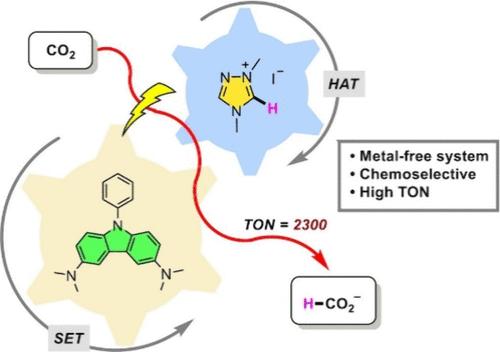当前位置:
X-MOL 学术
›
ACS Sustain. Chem. Eng.
›
论文详情
Our official English website, www.x-mol.net, welcomes your
feedback! (Note: you will need to create a separate account there.)
Triazolium-Catalyzed Metal-Free Photochemical Reduction of CO2 into Formate
ACS Sustainable Chemistry & Engineering ( IF 7.1 ) Pub Date : 2024-11-08 , DOI: 10.1021/acssuschemeng.4c07137 Weibin Xie, Masaaki Fuki, Ayana Sukegawa, Kenji Okunaka, Masahiko Hayashi, Yasuhiro Kobori, Ryosuke Matsubara
ACS Sustainable Chemistry & Engineering ( IF 7.1 ) Pub Date : 2024-11-08 , DOI: 10.1021/acssuschemeng.4c07137 Weibin Xie, Masaaki Fuki, Ayana Sukegawa, Kenji Okunaka, Masahiko Hayashi, Yasuhiro Kobori, Ryosuke Matsubara

|
The use of renewable solar energy for the photochemical CO2 reduction reaction (CO2RR) has garnered significant interest owing to its dual benefits: reducing the greenhouse effect and producing high-energy alternatives to fossil fuels. Transition metals play a crucial role in catalyzing the CO2RR; however, their scarcity and high cost pose challenges in achieving sustainable chemistry. In this study, we developed a metal-free CO2RR catalytic system using triazolium, a small and structurally simple compound, as the key catalyst. Visible-light irradiation of a solution containing a carbazole photosensitizer and triazolium salt under 1 atm pressure of CO2 afforded formate in high yield at room temperature. No other reduced products of CO2 were detected. The turnover number of the catalyst exceeded 2300, indicating high catalytic activity and durability. Mechanistic studies revealed that the triazolium salt serves as a hydrogen atom transfer (HAT) catalyst, with a carbon-centered radical as the catalytically active species. A study on the relationship between the chemical structure and the catalytic activity of various triazolium analogs elucidated the essential structural properties required for carbon-centered HAT catalysts. The results provide valuable insights for future research on CO2RR utilizing transition metal-free organic molecules as catalysts, which could contribute to environmentally friendly and sustainable methods.
中文翻译:

三唑催化的无金属光化学将 CO2 还原成甲酸盐
使用可再生太阳能进行光化学 CO2 还原反应 (CO2RR) 因其双重好处而引起了人们的极大兴趣:减少温室效应和生产化石燃料的高能替代品。过渡金属在催化 CO2RR 中起着至关重要的作用;然而,它们的稀缺性和高成本对实现可持续化学构成了挑战。在这项研究中,我们开发了一种无金属的 CO2RR 催化系统,使用三唑鎓(一种小而结构简单的化合物)作为关键催化剂。在 1 个大气压的 CO2 下对含有咔唑光敏剂和三唑盐的溶液进行可见光照射,在室温下得到高产率的甲酸盐。未检测到其他 CO2 还原产物。催化剂的周转数超过 2300,表明具有很高的催化活性和耐久性。机理研究表明,三唑盐用作氢原子转移 (HAT) 催化剂,碳中心自由基作为催化活性物质。对各种三唑鎓类似物的化学结构和催化活性之间关系的研究阐明了碳中心HAT催化剂所需的基本结构性质。研究结果为未来利用无过渡金属有机分子作为催化剂的 CO2RR 研究提供了有价值的见解,这可能有助于实现环保和可持续的方法。
更新日期:2024-11-08
中文翻译:

三唑催化的无金属光化学将 CO2 还原成甲酸盐
使用可再生太阳能进行光化学 CO2 还原反应 (CO2RR) 因其双重好处而引起了人们的极大兴趣:减少温室效应和生产化石燃料的高能替代品。过渡金属在催化 CO2RR 中起着至关重要的作用;然而,它们的稀缺性和高成本对实现可持续化学构成了挑战。在这项研究中,我们开发了一种无金属的 CO2RR 催化系统,使用三唑鎓(一种小而结构简单的化合物)作为关键催化剂。在 1 个大气压的 CO2 下对含有咔唑光敏剂和三唑盐的溶液进行可见光照射,在室温下得到高产率的甲酸盐。未检测到其他 CO2 还原产物。催化剂的周转数超过 2300,表明具有很高的催化活性和耐久性。机理研究表明,三唑盐用作氢原子转移 (HAT) 催化剂,碳中心自由基作为催化活性物质。对各种三唑鎓类似物的化学结构和催化活性之间关系的研究阐明了碳中心HAT催化剂所需的基本结构性质。研究结果为未来利用无过渡金属有机分子作为催化剂的 CO2RR 研究提供了有价值的见解,这可能有助于实现环保和可持续的方法。


















































 京公网安备 11010802027423号
京公网安备 11010802027423号